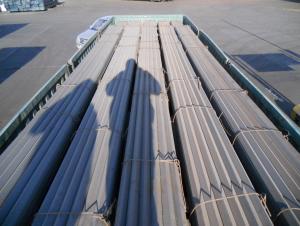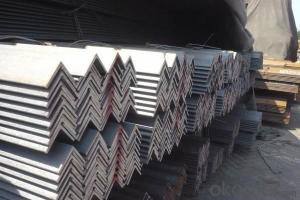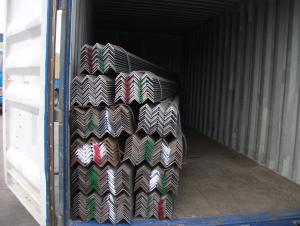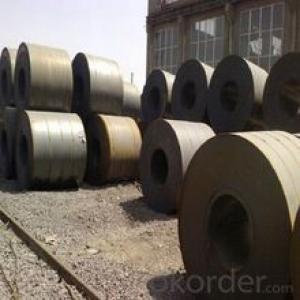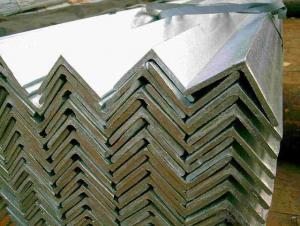JIS SS400 Hot Rolled Angle Steel
- Loading Port:
- China Main Port
- Payment Terms:
- TT or LC
- Min Order Qty:
- -
- Supply Capability:
- -
OKorder Service Pledge
OKorder Financial Service
You Might Also Like
Product Description:
OKorder is offering high quality Angle Steel at great prices with worldwide shipping. Our supplier is a world-class manufacturer of steel, with our products utilized the world over. OKorder annually supplies products to European, North American and Asian markets. We provide quotations within 24 hours of receiving an inquiry and guarantee competitive prices.
Product Applications:
According to the needs of different structures, Angle can compose to different force support component, and also can be the connections between components. It is widely used in various building structures and engineering structures such as roof beams, bridges, transmission towers, hoisting machinery and transport machinery, ships, industrial furnaces, reaction tower, container frame and warehouse etc.
.
Product Advantages:
OKorder's Angle Steel are durable, strong, and resist corrosion.
Main Product Features:
· Premium quality
· Prompt delivery & seaworthy packing (30 days after receiving deposit)
· Corrosion resistance
· Can be recycled and reused
· Mill test certification
· Professional Service
· Competitive pricing
Product Specifications:
1.Standards:GB,ASTM,BS,AISI,DIN,JIS
2.Invoicing on theoretical weight or actual weight as customer request
3.Material: JIS G3192,SS400;SS540.
4. Payment terms:
1).100% irrevocable L/C at sight.
2).30% T/T prepaid and the balance against the copy of B/L.
3) 30% T/T prepaid and the balance against L/C
4. Material Specifications:
Grade | Yield Strength,N/mm² | Extension Strength N/mm² | |||
Thickness of Steel,mm | |||||
≦16 | >16-≦40 | >40-≦100 | >100 | ||
SS330 | ≧205 | ≧195 | ≧175 | ≧165 | 330-430 |
SS400 | ≧245 | ≧235 | ≧215 | ≧205 | 400-510 |
SS490 | ≧285 | ≧275 | ≧255 | ≧245 | 490-610 |
SS540 | ≧400 | ≧390 | - | - | ≧540 |
FAQ:
Q1: Why buy Materials & Equipment from OKorder.com?
A1: All products offered byOKorder.com are carefully selected from China's most reliable manufacturing enterprises. Through its ISO certifications, OKorder.com adheres to the highest standards and a commitment to supply chain safety and customer satisfaction.
Q2: How do we guarantee the quality of our products?
A2: We have established an advanced quality management system which conducts strict quality tests at every step, from raw materials to the final product. At the same time, we provide extensive follow-up service assurances as required.
Q3: How soon can we receive the product after purchase?
A3: Within three days of placing an order, we will begin production. The specific shipping date is dependent upon international and government factors, but is typically 7 to 10 workdays.
Images:

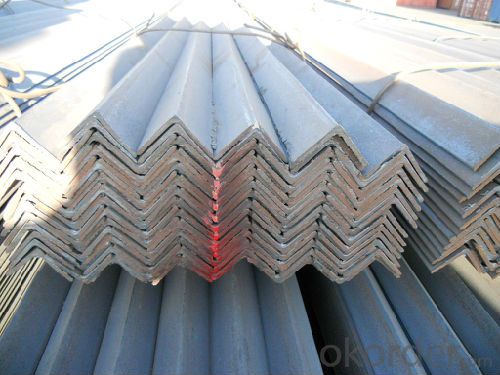
- Q: What are the common connections or fasteners used with steel angles?
- The common connections or fasteners used with steel angles are bolts, screws, rivets, and welds. These methods are commonly used to securely fasten steel angles to other structural elements or to join multiple steel angles together.
- Q: Can steel angles be used in earthquake-resistant construction?
- Indeed, earthquake-resistant construction can incorporate steel angles. Due to their exceptional strength and durability, steel angles are frequently employed as structural elements in buildings. In earthquake-resistant construction, steel angles serve the purpose of offering supplementary bracing and reinforcement to the structural system of the building. Through strategic placement, such as at the corners or edges, steel angles aid in the more efficient distribution of earthquake forces and mitigate the risk of structural failure. Moreover, steel angles can be utilized to construct moment-resisting frames or as part of a steel moment frame system, which is highly effective in withstanding lateral forces during an earthquake. In summary, steel angles play a vital role in enhancing a building's seismic performance and are a valuable asset in earthquake-resistant construction.
- Q: Can steel angles be used in bridge construction?
- Certainly, steel angles are an essential component in the construction of bridges. Known as L-shaped structural steel, they serve as crucial cross-sectional supports in bridge construction. Their ability to provide stability, strength, and rigidity makes them highly valuable in bridge structures. Steel angles exhibit versatility, making them suitable for different bridge elements like beams, trusses, and bracing systems. To ensure the integrity and load-carrying capacity of the bridge, these angles are often welded or bolted together to create structural connections. The advantages of steel angles in bridge construction include a high strength-to-weight ratio, durability, and resistance to corrosion. As a result, steel angles are widely relied upon and used in the construction of bridges.
- Q: What is 4# angle iron? What are the classifications of angle iron? What are the specifications? Thank you
- Angle called angle, the steel strip is perpendicular to each other on both sides into the corner. There are equal angles and unequal angles. The two sides of an equal angle steel are equal in width. The specifications are expressed in millimeters of edge width * edge width * edge thickness. Such as "/ 30 x 30 x 3", that is 30 mm width equal angle, edge thickness of 3 mm. Also available models that model is the number of centimeters wide, such as angle 3#. The model does not mean the size of the different edges and sizes of the same model. Therefore, the width, the edge and the thickness of the angle iron should be filled out in the contract and other documents, so as not to be indicated by the model alone. Standard Specification for hot-rolled equal angle iron is 2#-20#. The angle iron can be made up of different force components according to the different structure, and can also be used as the connecting piece between the components. Widely used in a variety of architectural and engineering structures, such as beams, bridges, towers, hoisting and conveying machinery, ships, industrial furnace, reaction tower, container frame and warehouse.
- Q: Can steel angles be fire-resistant?
- Yes, steel angles can be fire-resistant. Steel, as a material, has inherent fire-resistant properties due to its high melting point and low thermal conductivity. When exposed to high temperatures, steel angles can maintain their structural integrity and resist deformation for a considerable amount of time. Additionally, steel angles can be further enhanced for fire resistance through various methods such as applying fire-resistant coatings or incorporating fire-resistant materials in their design. These measures help to increase the fire resistance of steel angles, making them suitable for applications where fire protection is necessary, such as in the construction of fire-resistant walls, ceilings, and structural systems.
- Q: How do you calculate the bending capacity of a steel angle?
- To calculate the bending capacity of a steel angle, you need to determine the moment of inertia of the angle section and the maximum allowable stress. The moment of inertia is calculated using the dimensions of the angle section, and the maximum allowable stress is typically provided by the steel manufacturer. By applying these values to the appropriate bending equation, you can calculate the bending capacity of the steel angle.
- Q: What are the different types of steel angles used in bridges?
- A variety of steel angles are commonly utilized in bridge construction for different purposes. These include: 1. Equal Leg Angles: These angles possess equal legs and are frequently employed to provide structural support in bridge construction. They contribute stability and strength to the bridge structure. 2. Unequal Leg Angles: These angles have uneven legs and are used when additional strength or specific load-bearing requirements are necessary. They are often combined with equal leg angles to evenly distribute weight and provide support. 3. L-Shaped Angles: L-shaped angles serve various purposes in bridge construction, such as connecting beams and columns or offering additional support at connection points. They are often used in conjunction with other angle types to create a robust and well-supported bridge structure. 4. Tapered Angles: Tapered angles find application in bridges where a change in width or height is required. They are frequently utilized in bridge piers or abutments to ensure a seamless transition between different sections of the bridge. 5. Bent Angles: Bent angles are used in bridges that require a specific angle to accommodate the design or alignment of the bridge. These angles are often custom-made to suit the specific needs of the bridge construction project. 6. Hollow Structural Section (HSS) Angles: HSS angles are hollow steel sections employed in bridge construction to enhance strength and reduce the overall weight of the structure. They are commonly utilized in situations where weight reduction is a priority, such as in long-span bridges or bridges with high load-bearing requirements. Each of these steel angles serves a distinct purpose in bridge construction, and their selection depends on factors such as design requirements, load-bearing capacity, and structural stability necessary for the bridge.
- Q: How do steel angles resist bending or deflection?
- Steel angles are able to resist bending or deflection because of their shape and material properties. The L-shaped cross-section of steel angles contributes to their structural stability and strength, resulting in a high resistance to bending or deflection under load. The L-shape of steel angles creates two legs that are perpendicular to each other. This design allows for a more efficient distribution of the applied load compared to other shapes. As a result, the angles are able to resist bending forces, preventing significant deformation or deflection. The longer leg of the angle provides greater leverage and stiffness, further enhancing its resistance to bending. In addition to the shape, steel itself is a strong and rigid material known for its high tensile and compressive strength. Steel angles are typically made from hot-rolled steel, which undergoes a process that improves its structural properties. The combination of the L-shape design and the inherent strength of steel enables steel angles to withstand bending forces without significant deflection. Furthermore, steel angles can be reinforced through methods such as welding or bolting to increase their resistance to bending or deflection. These reinforcements add extra strength and stiffness to the angles, making them even more robust and capable of handling higher loads. To summarize, steel angles resist bending or deflection due to their L-shape design, the inherent strength of steel, and possible reinforcements. These factors work together to provide structural stability and prevent excessive deformation, making steel angles a reliable choice for various construction and engineering applications.
- Q: How do you determine the resistance to lateral-torsional buckling of a steel angle?
- There are several factors that need to be taken into account when determining the resistance to lateral-torsional buckling of a steel angle. The primary factors that influence this resistance are the geometric properties of the angle section, the material properties of the steel, and the boundary conditions of the member. 1. Geometric properties: The resistance to lateral-torsional buckling is affected by critical geometric properties such as the length, width, thickness, and slenderness ratio of the angle section. The slenderness ratio, which is the ratio of the length to the radius of gyration of the section, is particularly important as it indicates the stability of the member. A higher slenderness ratio implies a greater susceptibility to lateral-torsional buckling. 2. Material properties: The resistance to lateral-torsional buckling also depends on the material properties of the steel angle. Factors such as the yield strength, modulus of elasticity, and the shape of the stress-strain curve play a significant role in determining the capacity of the steel angle to withstand bending and twisting moments without buckling. 3. Boundary conditions: The resistance to lateral-torsional buckling is significantly influenced by the boundary conditions of the steel angle. The type of support and the loading conditions both play a crucial role. The type of support, whether it is simply supported or fixed, determines the level of rotational and translational constraints on the member. Similarly, the applied loads, such as point loads, distributed loads, or moments, determine the bending and twisting moments that act on the angle section. To determine the resistance to lateral-torsional buckling, engineers typically refer to relevant design codes and standards, such as the AISC Manual or Eurocode. These codes provide design formulas and tables that take into consideration the geometric properties, material properties, and boundary conditions. They allow engineers to calculate the critical moment and corresponding resistance to lateral-torsional buckling for the steel angle. Additionally, advanced computer simulations, such as FEA software, can be used to obtain more accurate results by considering complex loadings and boundary conditions.
- Q: What are the different types of steel angles used in HVAC systems?
- There are several types of steel angles commonly used in HVAC systems, including L-shaped angles, V-shaped angles, and Z-shaped angles. These angles are used to provide structural support, reinforcement, and stability in ductwork and other HVAC components.
Send your message to us
JIS SS400 Hot Rolled Angle Steel
- Loading Port:
- China Main Port
- Payment Terms:
- TT or LC
- Min Order Qty:
- -
- Supply Capability:
- -
OKorder Service Pledge
OKorder Financial Service
Similar products
Hot products
Hot Searches
Related keywords
